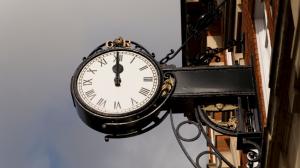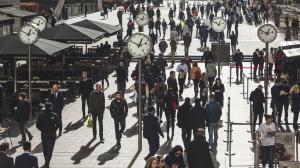
Best Comet of 2025?
C/2024 G3 (ATLAS) has already become very faintly visible to the naked eye for observers in the Southern Hemisphere.
Christmas Eve, which is the day before Christmas Day, is celebrated in many countries worldwide. It is a Christian observance that falls on December 24 in the Gregorian calendar.

Christmas trees are decorated with baubles, lights and tinsel during the Christmas season.
©iStockphoto.com/GMVozd
Many people around the world celebrate Christmas Eve in different ways. It is observed in many countries such as Australia, Canada, the United Kingdom and the United States. Workers in some countries get a day off or half-day off to prepare for Christmas Day, including last-minute shopping for presents, decorations or food. In some countries Christmas Eve is celebrated with large family meals featuring traditional Christmas dishes. In some cultures, presents are exchanged and opened on the night of Christmas Eve. Many homes have their Christmas trees lit up, mistletoes hung, and other Christmas decorations, such as holly and ivy, at this time of the year. Some also have Advent Calendars.
Some people organize groups of singers who go Christmas caroling from door to door, or sing Christmas carols in public venues. It is also a time for children in many countries around the world to hang their Christmas stockings (or pillow cases), hoping for a present to arrive from Santa Claus on Christmas Day, which is December 25 in the Gregorian calendar. Children in France set out their shoes near a fireplace on Christmas Eve because they believe that Father Christmas (Santa Claus), also known as le Père Noël (in French), will arrive before dawn and fill them with toys, nuts and sweets.
Many churches hold special services during Christmas Eve, including midnight services. These services include special choirs and sermons to celebrate the birth of Jesus Christ. Many churches also display a crèche or miniature Nativity scene. Christmas celebrations in different countries combine the country’s cultural traditions, beliefs and superstitions with more contemporary customs, such as Santa Claus and Christmas trees.
Alcoholic witches and Christmas poop: 7 weird Christmas traditions
Christmas Eve is a public holiday in countries such as the Czech Republic and Estonia. Some banks and businesses are closed in some countries, including Austria and Germany, on Christmas Eve. Many people in countries such as Brazil have the afternoon off work on Christmas Eve.
Some stores are often open late to accommodate for last-minute Christmas shopping in some cities around the world. Schools and educational institutions are usually closed on Christmas Eve as it falls as part of either the winter (northern hemisphere) or summer (southern hemisphere) vacation period. Airports, bus stations and train stations may be busy as many people travel to visit their families around this time of the year.
Christmas Eve, also known as the Vigil of Christmas, is perceived as the culmination of the Advent season. Christmas Eve is the day before Christmas Day and is associated with celebrating Jesus Christ’s birth, although his actual birth date has been disputed among many scholars. However, many Christmas traditions that are around today have their roots in pre-Christian winter festivals. These include the importance of candles and decorations made from evergreen bushes and trees, symbolizing everlasting light and life.
In Roman times, a mid-winter festival was held. This was a relaxing time with a lot of parties and merry making. It was also common to give other people small gifts, such as dolls for children and candles for adults. This festival culminated with the celebration of the winter solstice, which fell on December 25 in the Roman calendar.
Since pagan times, it was customary to decorate with greenery on festivals, especially with holly, ivy, and mistletoe. After some debate, the church authorities permitted it to be done on Christian festivals, at least from the early seventh century in England. Holly and ivy were associated with good and evil, or male and female, and so were often combined. Mistletoe has pagan associations. For example, the druids of Gaul regarded mistletoe growing on oak trees as sent from heaven.
Images of Santa Claus, also known as Father Christmas, snowmen, reindeer, and candy canes are seen in cards, posters, signs and other printed or marketing material associated with the Christmas celebrations. Images of baby Jesus, the Christmas star, and other symbols associated with the religious meaning of Christmas are also seen during Christmas Eve and Christmas Day.

C/2024 G3 (ATLAS) has already become very faintly visible to the naked eye for observers in the Southern Hemisphere.

How does the 12-hour clock system work? Is midnight 12 am or 12 pm?

Why do many countries set the clocks back and forth an hour twice a year?

Why are there 12 months? How long are they, and what do the month names mean?